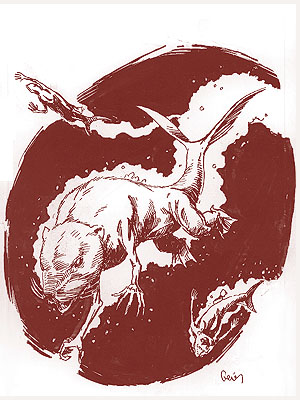
Jorri
Resembling nothing so much as otters, these creatures can be found in the seas and along the shoreline of the Savage Coast. They can also be a great source of information to those who treat them well and are often quite helpful a crisis.
Jorries are small, ranging from two to four feet in length, with stubby legs for such long bodies. The two rear legs end in large feet with long, webbed toes that can spread wide for stronger paddling. A jorri's crescent-shaped tail and back feet work together in single thrusts to move the jorri through the water quickly.
The front claws of a jorri are long and sharp, perfect for prying food out of shells or defending itself. Short, oily fur covers the entire body of the jorri, appearing dark grey with black spots. Jorries have bristly, white whiskers for feeling their way through dark places.
This fairly intelligent creature can speak a broken version of the common tongue. Its vocabulary contains many nautical terms and colourful expressions, indicating an obvious verbal rapport between jorries and sailors.
The Red Curse: Jorries hardly ever (10%) acquire Legacies. However, if a jorri does acquire a Legacy, it will require cinnabryl to fight off Affliction. Most simply become Afflicted rather than constantly seek this magical metal.
Combat: Jorries would rather avoid combat, but they will fight if threatened, sometimes even coming to the aid of others.
When attacking, a jorrie will charge in with a fierce bite and a scrabbling attack of claws, each front claw getting two attacks. If the bite is successful, the jorri locks its jaws and cannot be dislodged without a successful bend bars roll (assuming the creature can get its hands on the jorri's jaws).The bite does no further damage, but it does negate any AC adjustment for Dexterity. The jorri simply rides along and continues to tear at its opponent with its front claws. Jorries are smart enough to recognise vulnerable areas, and they try to attack spots their opponents might not be able to reach easily (such as the underbelly of a horse).
Habitat/Society: Jorries live and travel in family groups. A jorri couple might have up to three young each year for several years. They make a den along the seashore, padding it with dried rushes or flat grasses. Jorries tend to feed on small fish and molluscs. Borrowing a tactic from their distant cousin, the otter, many jorries also use rocks for cracking the shells of more well-protected food.
Jorries are often seen riding waves or sunning themselves on the beach. They love stormy weather, playing out where the water is roughest and along reefs where turbulence makes their diving more exciting. The pleasure they take from such weather does not blind them to its danger for others, however. Jorries will try to warn any ships they see approaching dangerous water; if they can, they will rescue swimmers in trouble or victims of shipwrecks. Some jorries can see through the subterfuge of the sea hermit and will warn potential victims. Though not often, jorries might ask a small service from someone they have saved.
Ecology: Jorries
are beneficial to the sea life surrounding the Savage Coast. They assist those
in trouble and feed on creatures in plentiful supply. The jorri population is
kept down by echyans and a few other large sea predators. Jorries have
beautiful pelts, but hunting them is thought to be in very bad taste; sailors
actively defend jorries against any hunters.
